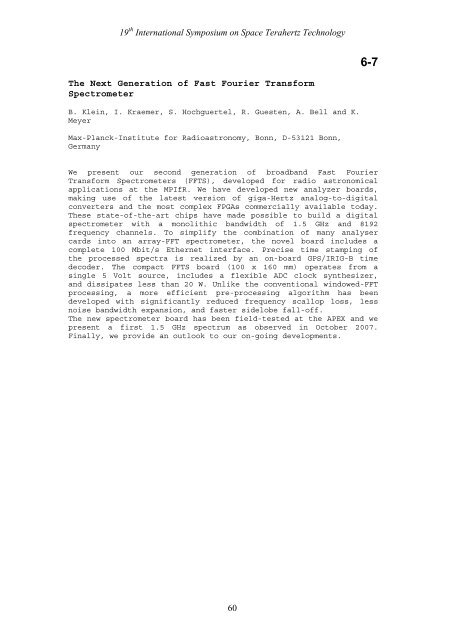Program and Abstract Book - SRON
Program and Abstract Book - SRON
Program and Abstract Book - SRON
Create successful ePaper yourself
Turn your PDF publications into a flip-book with our unique Google optimized e-Paper software.
19 th International Symposium on Space Terahertz Technology<br />
6-7<br />
The Next Generation of Fast Fourier Transform<br />
Spectrometer<br />
B. Klein, I. Kraemer, S. Hochguertel, R. Guesten, A. Bell <strong>and</strong> K.<br />
Meyer<br />
Max-Planck-Institute for Radioastronomy, Bonn, D-53121 Bonn,<br />
Germany<br />
We present our second generation of broadb<strong>and</strong> Fast Fourier<br />
Transform Spectrometers (FFTS), developed for radio astronomical<br />
applications at the MPIfR. We have developed new analyzer boards,<br />
making use of the latest version of giga-Hertz analog-to-digital<br />
converters <strong>and</strong> the most complex FPGAs commercially available today.<br />
These state-of-the-art chips have made possible to build a digital<br />
spectrometer with a monolithic b<strong>and</strong>width of 1.5 GHz <strong>and</strong> 8192<br />
frequency channels. To simplify the combination of many analyser<br />
cards into an array-FFT spectrometer, the novel board includes a<br />
complete 100 Mbit/s Ethernet interface. Precise time stamping of<br />
the processed spectra is realized by an on-board GPS/IRIG-B time<br />
decoder. The compact FFTS board (100 x 160 mm) operates from a<br />
single 5 Volt source, includes a flexible ADC clock synthesizer,<br />
<strong>and</strong> dissipates less than 20 W. Unlike the conventional windowed-FFT<br />
processing, a more efficient pre-processing algorithm has been<br />
developed with significantly reduced frequency scallop loss, less<br />
noise b<strong>and</strong>width expansion, <strong>and</strong> faster sidelobe fall-off.<br />
The new spectrometer board has been field-tested at the APEX <strong>and</strong> we<br />
present a first 1.5 GHz spectrum as observed in October 2007.<br />
Finally, we provide an outlook to our on-going developments.<br />
60
















